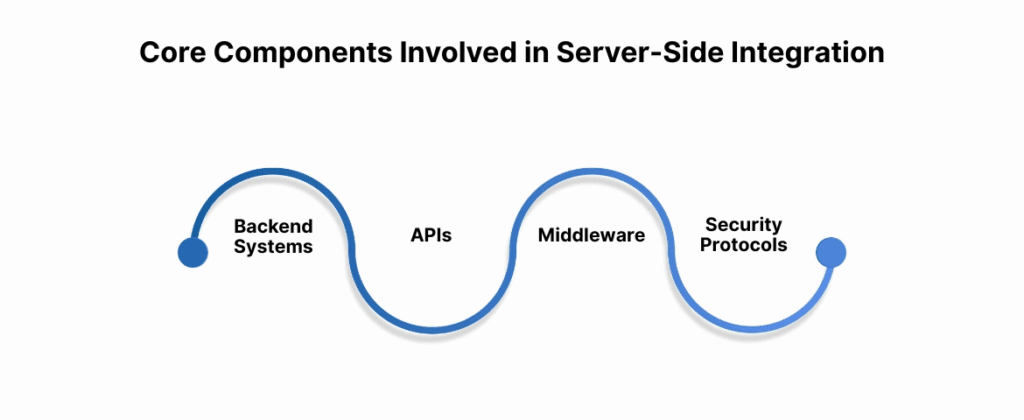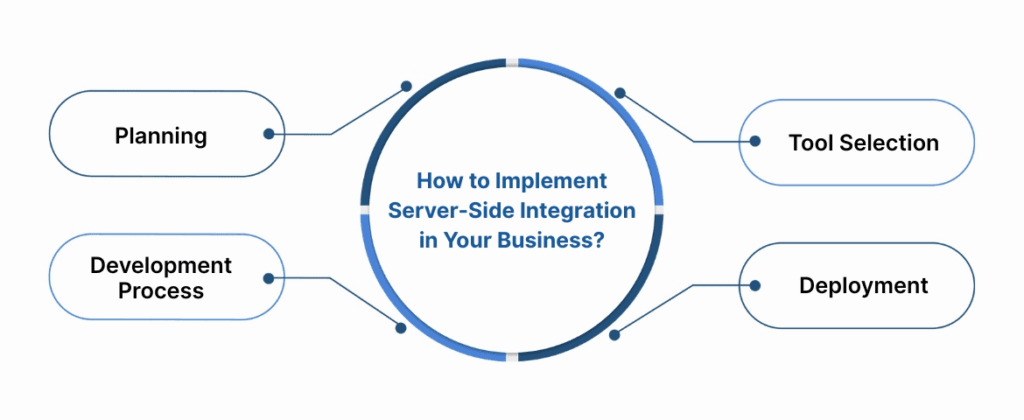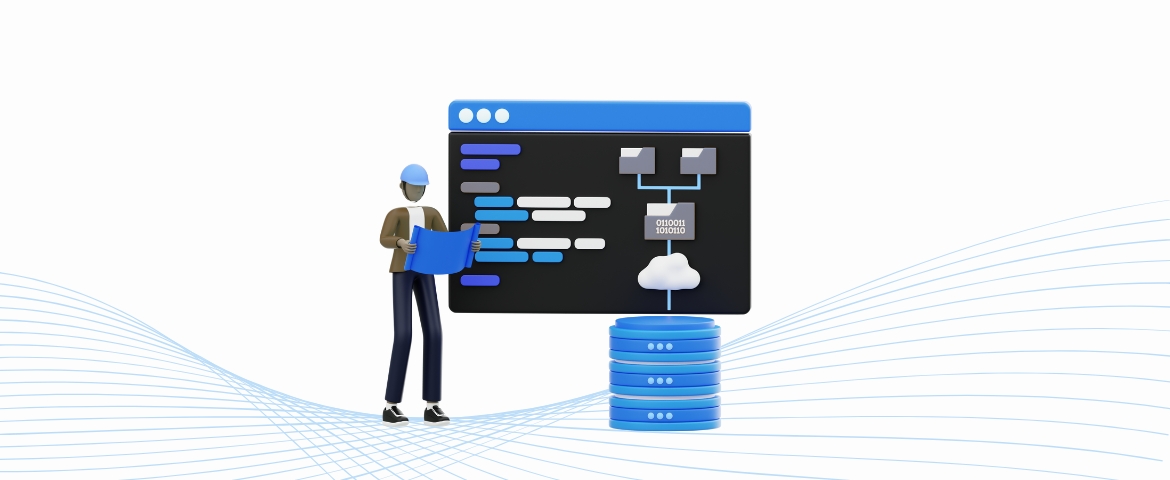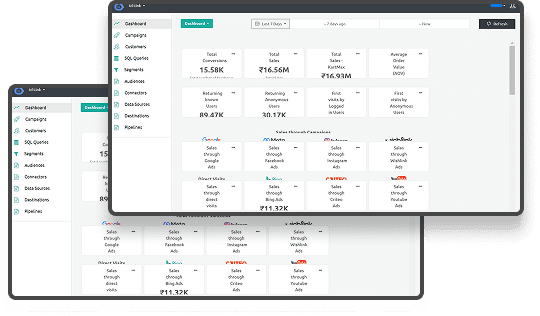Server-Side Integration: A Comprehensive Guide
Are you looking to improve the efficiency and security of your business systems?
As organizations face increasing pressure to meet rising demands, server-side integration has become a key method to address these challenges. It simplifies how different systems communicate, helps maintain data consistency, and reduces reliance on client-side processes. However, transitioning to a server-side integrated system can come with challenges, such as managing complex workflows and ensuring the system remains scalable.
A survey indicates that 55% of organizations plan to adopt generative AI solutions within the year, signaling a substantial surge in integration efforts. Additionally, the performance of IBM i workloads has increased by 50%, reducing the number of cores needed and resulting in high cost savings. These developments underscore the importance of effective server-side integration in achieving operational efficiency and cost-effectiveness.
This guide explores the fundamentals of server-side integration, its benefits, and best practices for implementation, providing valuable insights for organizations seeking to optimize their systems.
Understanding Server-Side Integration
Server-side integration connects various backend systems to ensure they function together smoothly. It's a key part of modern digital infrastructures. Unlike client-side integration, which runs directly on the user's device, server-side integration operates from the server. This setup is far more secure and efficient, especially when dealing with sensitive data.
Why is Server-Side Integration Important?
When working with sensitive information like payment details, authentication processes, or handling large data sets, server-side integration is often the best choice. Since it operates directly on the server, you have greater control over the security and integrity of your data. In contrast, client-side integration runs on the user's browser, which can be more vulnerable to security risks.
Here are a few scenarios where server-side integration becomes indispensable:
- Connecting legacy systems to newer technologies: If your systems are outdated and need to interact with more modern technologies, server-side integration bridges that gap without compromising security or performance.
- Unifying multiple databases for easier management: When your data is scattered across different databases, server-side integration can consolidate it into a single, more accessible location, making it easier to manage and analyze.
- Handling sensitive user data securely: Server-side integration is beneficial when processing sensitive data, like personal identification information or financial data. It helps you control who accesses this information and how it is stored.
- Supporting large-scale data processing: If you're dealing with high volumes of data, server-side integration ensures that all processes are handled efficiently, without putting unnecessary strain on your system or slowing down performance.
Now that you understand server-side integration better, let’s explore the components that make it work seamlessly. These elements work together to ensure your integration is secure, reliable, and capable of meeting your needs.
Key Components of Server-Side Integration
Several key components work together when implementing server-side integration to ensure your systems connect smoothly and securely. Let’s break down these components and their importance in ensuring everything runs without a hitch.
Core Components Involved in Server-Side Integration:

1. Backend Systems
Your backend systems include databases, application servers, and legacy systems where your critical data resides. Integrating these systems ensures data moves correctly between platforms without delays or errors. Whether using a traditional database or a more modern application server, seamless data flow is the foundation of effective integration.
2. APIs (Application Programming Interfaces):
APIs, such as RESTful APIs, SOAP, and GraphQL, are crucial for enabling communication between different software applications. They allow systems to exchange data in a structured and understandable way. APIs are the messengers between platforms, ensuring data is securely and accurately transferred. Applications would struggle to communicate without APIs, and data exchanges would become unnecessarily complex.
3. Middleware:
Middleware is the software that manages data flow between different applications and systems. It ensures that your systems, whether they run on various platforms or use different software, can communicate without issues. Think of it as a translator, ensuring both sides understand each other even if they're built using various technologies. Middleware prevents bottlenecks and reduces compatibility issues, making data exchange more efficient.
4. Security Protocols:
Security is paramount when it comes to server-side integration. Protocols like encryption, secure socket layer (SSL), and authentication processes keep your data safe during transfer. Security protocols ensure that the data remains confidential and that only authorized users or systems can access it. This is particularly important for sensitive information like payment details or personal user data. Without these security measures, your integration could be vulnerable to attacks or breaches.
Each component ensures your server-side integration is secure, efficient, and effective. Now that we’ve covered the key elements, let's look at how all these pieces work seamlessly.
How Server-Side Integration Works?

To understand server-side integration, it is essential to see how different components work together to make your systems run smoothly. At its core, server-side integration connects backend systems, ensuring data flows securely and efficiently without relying on client-side processing. By diving into the architecture, data flow, APIS, middleware, and authentication processes, you can see how this integration optimizes performance, improves security, and simplifies complex workflows.
Here’s a look at how server-side integration works:
Understanding the Server-Side Architecture
The server-side architecture is the backbone of integration. It consists of various servers, databases, and backend systems that store and manage data. These elements ensure that data is processed and exchanged securely between different applications. When you use server-side integration, everything happens on the server, not individual user devices, making the system faster and more secure.
Data Flow in Server-Side Integration
Data flow refers to how information travels between different systems. With server-side integration, data is sent from one system to the server, which is processed, stored, or transferred to other systems. Unlike client-side integration, where data is processed on the user's device, server-side integration ensures everything is handled securely and efficiently, preventing data loss or corruption during transfer.
The Role of APIs in Server-Side Integration
APIs are crucial for server-side integration. They act as bridges between systems, allowing them to communicate and exchange data. APIs like RESTful or SOAP are commonly used in server-side integrations because they can provide data in a structured and standardized way, making it easy for different platforms to understand and interact with each other.
Middleware and Data Processing
Middleware is the software that connects different systems, ensuring that data flows seamlessly between them. Think of it as the middleman between your backend systems, ensuring all applications can communicate smoothly, even running on different platforms. Middleware helps prevent issues like data bottlenecks or delays, keeping the system running efficiently.
Handling Authentication and Authorization (OAuth, JWT)
Authentication and authorization are key to ensuring that only the right people or systems can access sensitive data. To manage user access, server-side integration uses tools like OAuth and JWT (JSON Web Tokens). OAuth helps authorize third-party applications to access user data without revealing personal information, while JWT is often used to verify users securely. This way, you can be sure that your data stays protected, and only the right users or systems can access it.
By understanding these key aspects of server-side integration, you can see how it connects everything and why it’s important for maintaining security and efficiency. As we move forward, we’ll explore the direct benefits of server-side integration and why it's worth investing in your business.
Key Benefits of Server-Side Integration for Businesses

Server-side integration is not just about connecting different systems; it offers tangible benefits that can significantly improve your business’s operations. Let’s explore how it adds value and makes processes more efficient, secure, and cost-effective.
1. Improved Security
With server-side integration, all sensitive data is processed and transferred directly on the server, which reduces the risk of exposing this information to potential threats on the client side. By centralizing authentication processes and employing encryption for data transfers, your systems are better equipped to protect personal and business-critical data. This means more control over who has access to sensitive information and less vulnerability to attacks such as data breaches or fraud.
2. Faster Load Times
Handling data-heavy processes on the server, rather than relying on users’ devices, leads to faster application load times. By offloading tasks like complex data processing, calculations, or large file handling to the server, you prevent slowdowns on the client side. This enhances the user experience and improves overall system performance, making your business applications faster and more responsive, leading to higher user satisfaction and potentially more conversions.
3. Scalability for Growth
As your business expands, your systems must handle increasing data, traffic, and complexity without slowing down. Server-side integration makes this possible by allowing your backend systems to scale up easily without affecting the user experience on the front end. Whether adding new features, increasing traffic, or growing your customer base, server-side integration provides the flexibility to expand your infrastructure smoothly and efficiently, supporting your business as it evolves.
4. Consistent and Accurate Data
Data consistency across all systems is key to avoiding errors and miscommunications. With server-side integration, you ensure all connected systems access the same, up-to-date data. This centralization prevents discrepancies when data is handled separately across different platforms. It helps provide a “single source of truth” where teams and departments can rely on the same accurate information, leading to better decision-making and fewer operational mistakes.
5. Cost Efficiency:
Implementing server-side integration can lead to significant cost savings. You can lower infrastructure and maintenance costs by reducing the need to maintain multiple separate systems or duplicate data management processes. Additionally, you save on the resources required to handle data security and data management at the client level, shifting the workload to more efficient server-side processing. With server-side integration, the investment in your backend infrastructure pays off by reducing unnecessary overhead and operational costs.
In summary, server-side integration brings several advantages: better security, faster load times, scalability, improved data consistency, and cost savings. With tools like Ingest Labs' Ingest IQ, Ingest ID, and Event IQ, you can further enhance your systems’ security, performance, and scalability, allowing your business to grow while maintaining a smooth user experience. Let’s now explore how to begin implementing server-side integration in your business.
How to Implement Server-Side Integration in Your Business?

Implementing server-side integration requires careful planning and a structured approach to ensure smooth implementation. These detailed steps can make the integration process more manageable and ensure your systems work together effectively. Let’s break down each step with key points to help guide you through the process.
1. Planning
Planning is the foundation of any successful server-side integration. The integration process can be chaotic without proper planning, leading to delays and additional costs. Here’s how to effectively plan your integration:
- Assess Business Needs: Begin by identifying the business processes that need integration. What are your pain points? Are you facing issues with data silos, inconsistent reporting, or slow performance? Determine which systems need to be integrated to resolve these challenges.
- Evaluate Current Systems: Take stock of your existing infrastructure. What technologies are in place, and how can they be connected? Are there any legacy systems that need to be updated or replaced? Evaluating your current systems helps you understand the integration's scope and identify areas for improvement.
- Define Objectives: Be clear about your goals. Do you need better data flow, enhanced security, or faster load times? Defining your objectives ensures that the integration aligns with your overall business strategy.
- Set a Timeline: Establish a realistic timeline for the project. Factor in time for testing, deployment, and post-deployment monitoring. A clear timeline helps you stay on track and ensures all stakeholders know when to expect deliverables.
2. Tool Selection
Choosing the right tools for your server-side integration is essential to ensure smooth communication between different systems. Here’s how to select the best tools for your needs:
- Choose APIs for Communication: RESTful APIs, SOAP, or GraphQL are critical for enabling communication between your applications. They allow data to be exchanged between systems in a structured format, ensuring everything works seamlessly. If your goal is real-time data integration, consider using Ingest Labs' solutions, which provide server-side tracking and efficient data flow management.
- Select Middleware Platforms: Middleware software acts as a bridge between different systems, helping them communicate. This is especially useful if your systems run on various platforms or technologies. Middleware ensures that data is translated adequately between systems, preventing compatibility issues.
- Integrate Security Tools: Security is a top priority when implementing server-side integration. To protect sensitive information during the integration process, choose tools that offer strong encryption, secure data transfer, and authentication features. Ensure the tools you choose meet regulatory standards such as GDPR or CCPA.
- Consider Data Streaming Solutions: If you handle large volumes of data, you might need data streaming solutions to process and transfer data in real time. Ingest Labs' Data Streaming service allows you to manage large datasets efficiently without overwhelming your systems.
3. Development Process
The development phase involves coding and testing your integration to ensure it meets all requirements. Here's how to go about it:
- Write Clear, Efficient Code: Ensure the code is clean, modular, and easy to maintain. Poorly written code can lead to errors that are difficult to debug. Follow best coding practices and document your code correctly.
- Implement Error Handling: Always include error-handling mechanisms in your code. Anticipate potential issues and set up systems to alert you if something goes wrong. This will help you identify and fix problems quickly, reducing downtime.
Create a Testing Environment: Set up a testing environment that mirrors your production system. This allows you to simulate real-world scenarios and ensure the integration works as expected before going live. - Test Each Component: Don’t wait until the entire system is integrated to start testing. Test individual components and their interactions with other systems to identify issues early. This will save time and resources in the long run.
- User Acceptance Testing (UAT): Before deploying, have key users test the integration to ensure it meets their expectations. UAT allows you to catch any issues related to user experience and address them before the final deployment.
4. Deployment
Once development and testing are complete, it's time to deploy your server-side integration. Follow these steps to ensure a smooth deployment:
- Deploy in Phases: Rather than deploying the integration simultaneously, roll it out in phases. Start with a limited deployment to monitor its performance and resolve any issues before going live with the entire system. This staged approach reduces the risk of disruptions.
- Monitor System Performance: After deployment, actively monitor system performance to identify any unexpected issues. Set up real-time monitoring tools to track system health, user activity, and data flow.
- Post-Deployment Support: Provide adequate support after the integration is deployed. Ensure that a team can troubleshoot and resolve any post-deployment issues promptly. Collect feedback from users to identify any areas for improvement.
- Iterate Based on Feedback: Continuously improve the integration based on user feedback and system performance after deployment. Regular updates and refinements ensure the integration continues to meet your business needs.
Once you’ve set everything in place, it’s time to consider overcoming some of the most common challenges with server-side integration. Here’s how to address these challenges effectively and keep your integration running smoothly.
Overcoming Common Challenges in Server-Side Integration
Server-side integration can come with challenges, from data silos to security concerns. However, by addressing these issues head-on, you can ensure your integration continues to deliver value without interruptions.
Common challenges and solutions in server-side integration:
- Data Silos: If your data is scattered across different systems, integrating it can be tricky. To address this, implement a centralized data management solution that brings all your data into one place.
- Legacy System Integration: Older systems might not support modern integration techniques. In this case, middleware tools can help bridge the gap between old and new technologies.
- Security Risks: Exposing data during integration can lead to security vulnerabilities. Strong encryption and authentication protocols will help protect sensitive data.
- Performance Bottlenecks: As your systems grow, performance issues can arise. Regular system optimization and load balancing can help resolve these issues.
Addressing these challenges will ensure that your server-side integration continues to support your business without disruption. With tools like Ingest Labs' Ingest IQ, you can ensure that your integration remains secure, efficient, and scalable as your business grows.
Conclusion
Server-side integration is a powerful tool connecting your systems and improving your business's overall performance. It provides better security, faster load times, and a more scalable infrastructure. By following best practices and addressing common challenges, you can ensure your server-side integration continues to run smoothly as your business grows.
Suppose you're ready to improve your system integration. Ingest Labs offers the tools and expertise to make your server-side integration secure, efficient, and reliable. Contact us today to learn how we can help you integrate your systems easily.






